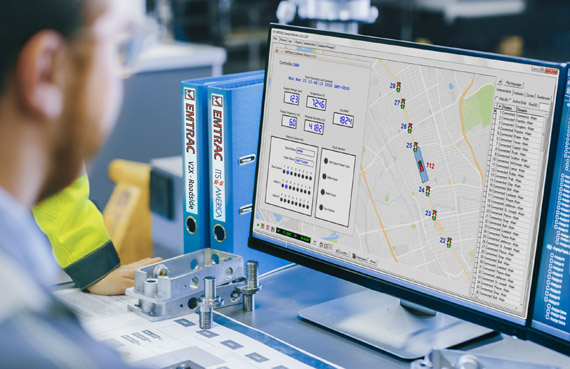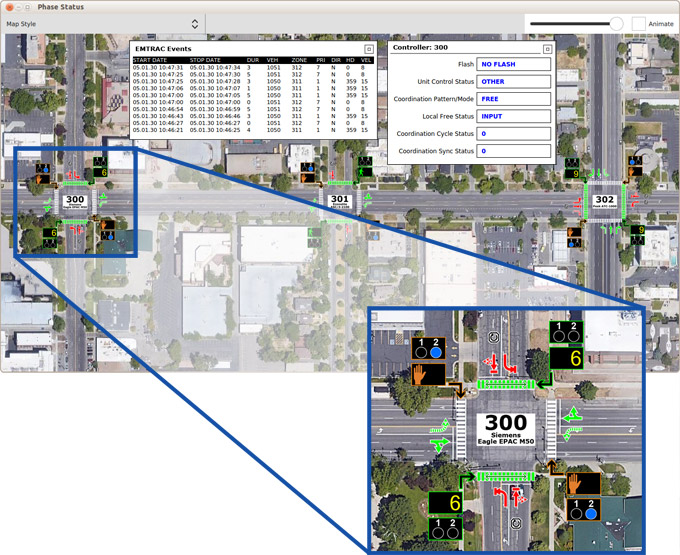May 22, 2020 – One of the key benefits of an intelligent traffic system is the ability for cities to maintain complete awareness of their system’s state of readiness. What are the conditions inside our traffic cabinets? How are our signals responding to current traffic conditions? Are the signals maintaining coordination? And so on.
The path toward a fully intelligent traffic system is built with many intermediate steps, and many of those steps often require full-blown projects of their own. However, cities now have an advantage that wasn’t available five or ten years ago. They can implement key ITS elements without incurring the expense required in years past.
The Traffic Center system enables cities to employ a wide range of ITS capabilities—and hardware installation is kept at a minimum. In most cases, a single EMTRAC component is installed in traffic cabinets (the ‘Roadside Unit’), and equipped vehicles carry another component (the ‘Vehicle Computer Unit’ and its connected GNSS Antenna).

The Roadside Unit is capable of wired and wireless communication. It facilitates V2I (vehicle-to-infrastructure) and V2V (vehicle-to-vehicle) communication through a number of protocols and means, including NTCIP, DSRC, SDLC, FHSS radio, cellular, and others. Its messaging capability also includes SPaT data (Signal Phase and Timing)—providing an important step toward assisting autonomous vehicles.
ITS Considerations
The full ITS scope is broad enough to cause concern among engineers, but the Traffic Center system renders many of these concerns unnecessary. Common concerns include:
Network Communications
For even well-connected cities, as much as 20 to 25 percent of their traffic cabinets are without wired network connections. Intersections without network connections also typically take the most time to service simply because they’re farther away.
With so many wireless options available, connectivity is not a problem with the Traffic Center system. Cities are able to quickly get their traffic cabinets on line so the information they need is available where and when they need it.
Traffic Operations Center
Does our city need an Advanced Traffic Operations Center to take advantage of the EMTRAC Traffic Center system?
In short, no. The data provided by the Traffic Center system may be displayed on a single workstation monitor—or it may be apportioned across a video wall with separate Traffic-Center modules displayed on their own screens. The system is flexible enough to meet the needs of cities both large and small.
The Traffic Center system includes a number of separate modules so cities can address their most-pressing needs—without paying for functionality they don’t need.. Available modules include:
-
Phase Status: The Phase Status module provides a map display of all equipped intersections, and it enables real-time display of current signal-phase states, loop detection, signal-coordination status, pedestrian inputs, signal preempt/priority status, and more.
Monitoring personnel are able to zoom out to display states for multiple intersections, or zoom in to view single intersections in greater detail (as shown).
-
Cabinet Status: System readiness starts at the control cabinet—and cabinets in remote locations are no exception. The Cabinet Status module provides alerts to designated personnel when faults are detected or when environmental or performance parameters fall outside defined thresholds.
Monitored states include power-supply status, cooling-fan speed, cabinet temperature & humidity, door status, as well as NTCIP-standard indicators to provide alerts when a wide range of system faults are detected. EMTRAC hardware provides accurate GPS time for all events and can provide corrections to controller real-time clocks.

-
Vehicle Status: The Vehicle Status module displays the real-time location and activity of all EMTRAC-equipped vehicles, including vehicle-detection zones and active priority requests. This module is typically used in conjunction with Emergency Vehicle Preemption (EVP) and Transit Signal Priority (TSP), also provided by EMTRAC.
-
App Integration: The Traffic Center System also integrates with the EMTRAC apps, which passively detect vehicles and pedestrians.
The Bicycle/Motorcycle Detection app solves a historically difficult problem, detecting and responding to bicycles at intersections.
The Pedestrian Detection & Signaling app provides a non-intrusive way to enhance pedestrian signaling systems and to encourage crosswalk usage—both key elements for increasing safety and accessibility. It also serves as an auxiliary aid and service to enable people with vision, hearing, or speech disabilities to recognize pedestrian signals and request crossing signals.
Whether implementing traffic-cabinet monitoring, phase-status monitoring, signal priority, vehicle detection, or other capabilities, the Traffic Center system provides the proven ITS-project solutions.
Would you like to see the system in action? Online or on-site demonstrations are available. Please contact us for more information.
